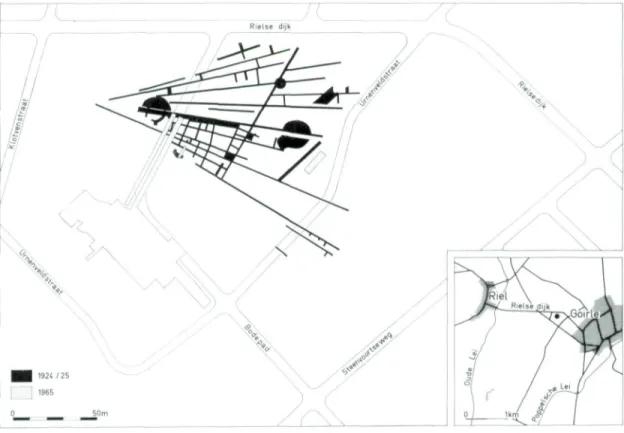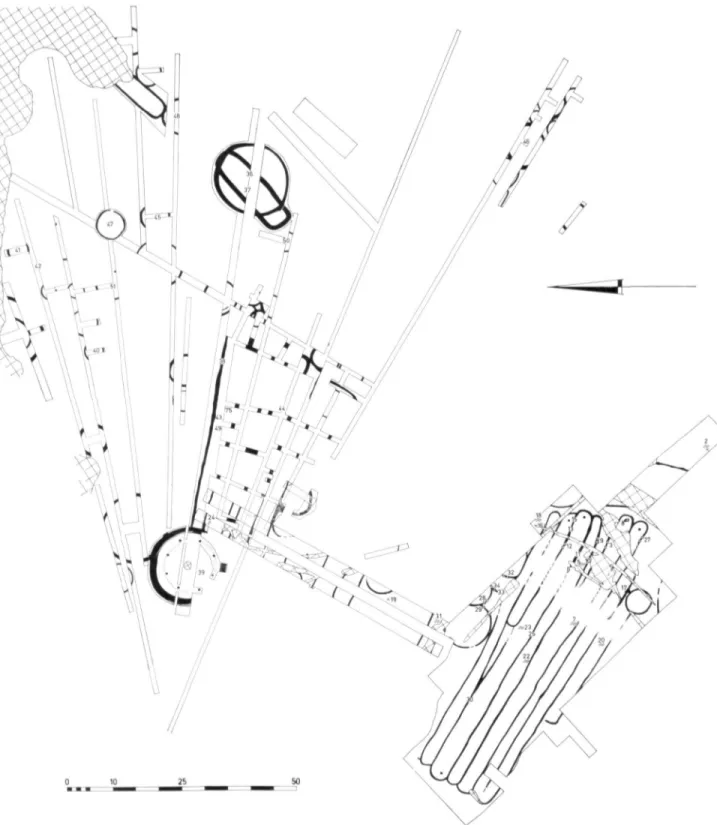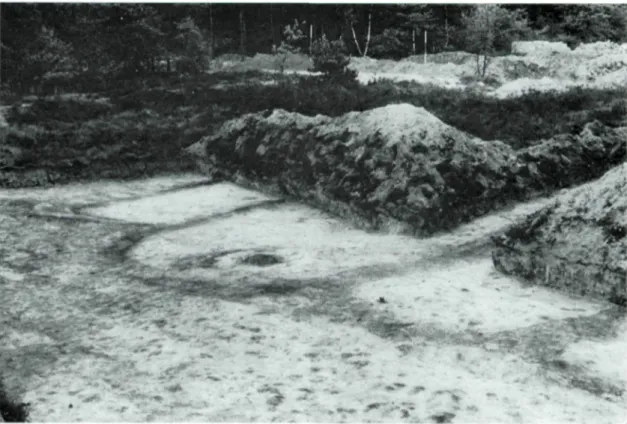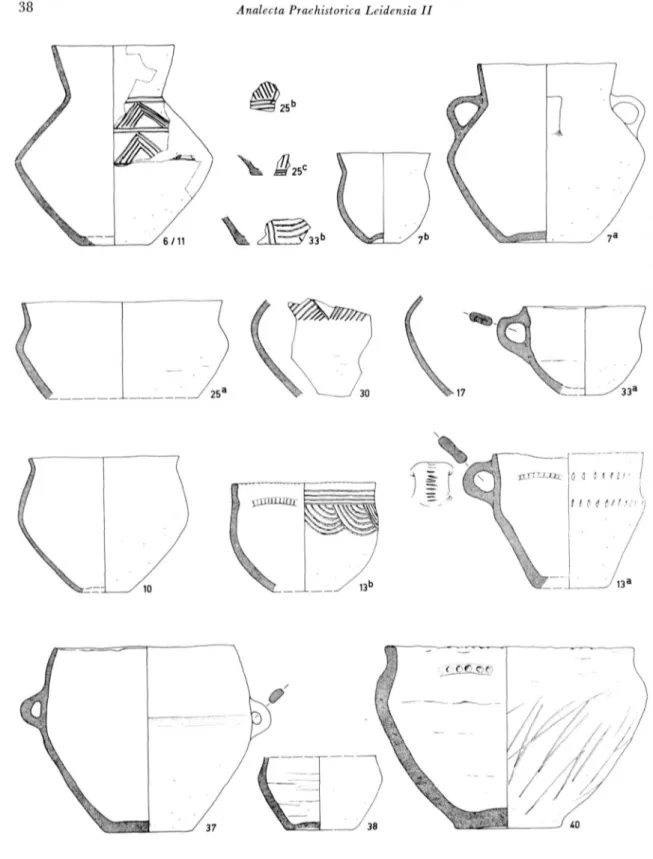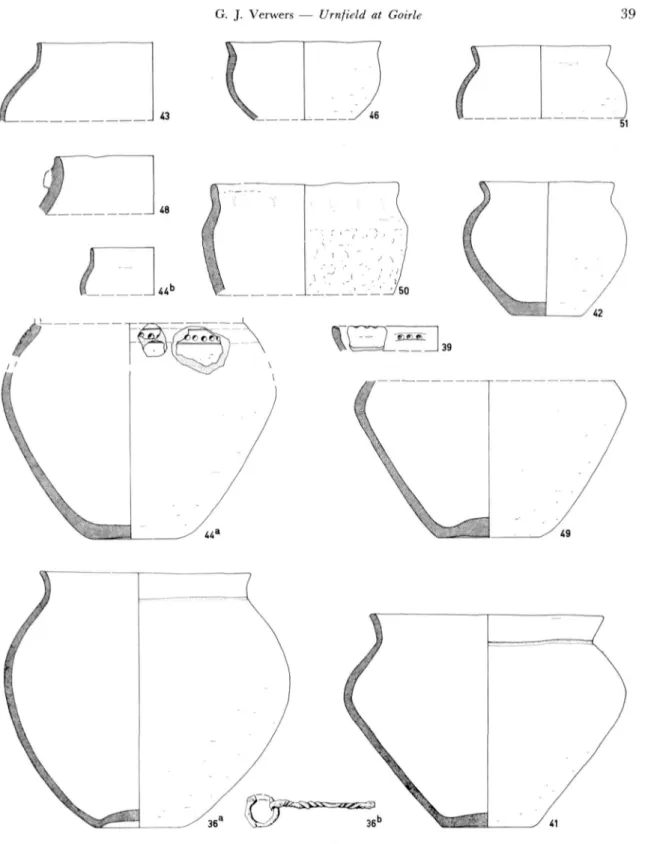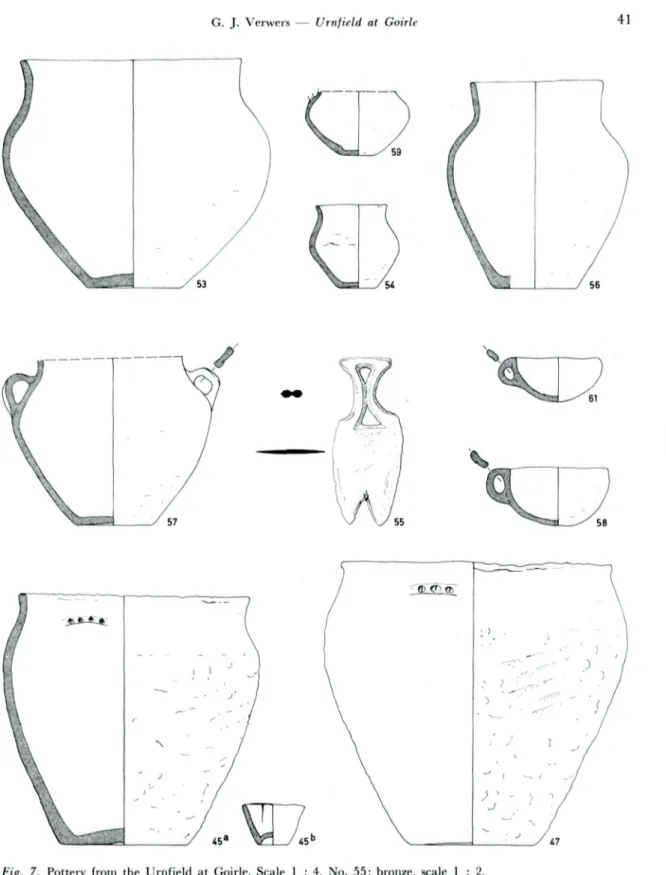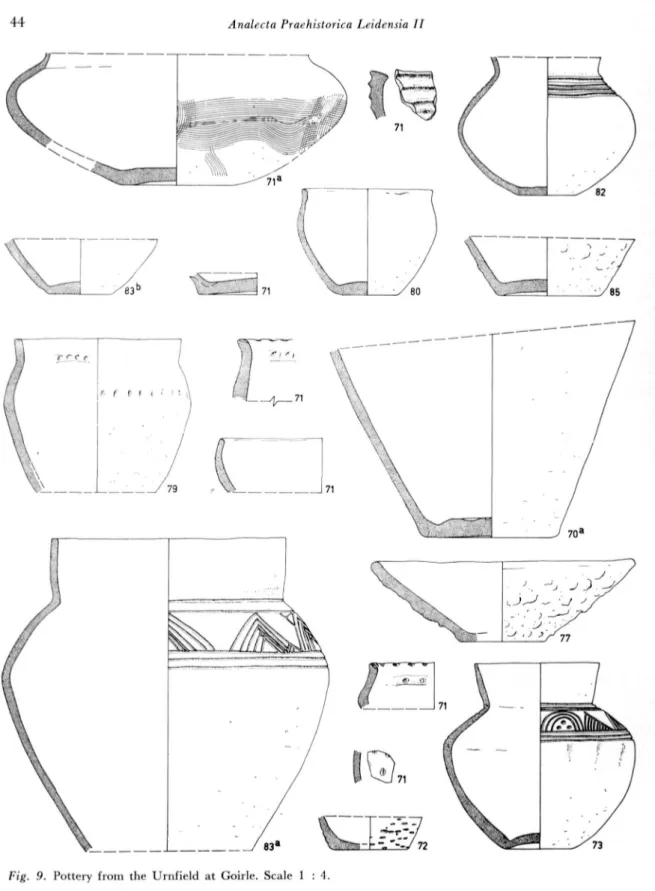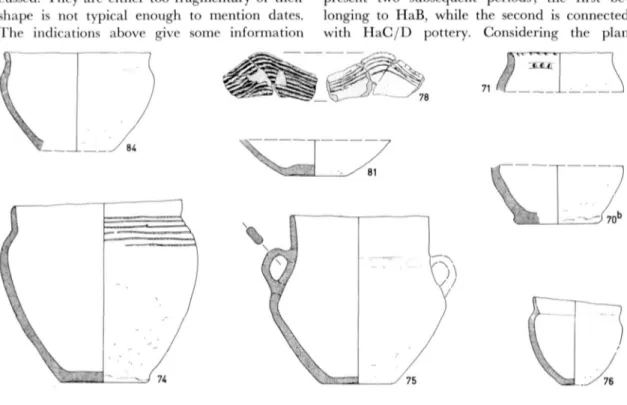A L A I E B R O N Z E A G E / E A R L Y I R O N A G E U R N F I E L D A T (; () I R L E, P R O V. N O O R D - B R A B A N T
G. J. V E R W E R S
In addition to the investigations of 1924j 1925 by A.E. Remouckamps, part of
mi urnfield at Goirle was excavated. The soilmarks belonged to two types of
monuments. Circular ditches had once surrounded low tumuli, which covered
urns of HaB and HaCjD date. Long parallel ditches bordered elongated
enclosures, measuring 60 X 3.5 m on the average. They were related to some
of the circular ditches. Sherds and charcoal, collected from their fillings, date
these monuments to HaB. They are interpreted as agricultural fields, that
served some purposes connected with the funeral rite. We propose for them the
name "Long Ditches of Goirle type".
Introduction
'Impressive' is what one might call the number of urns deriving from the 'urnenvelden' l in the southern part of the Netherlands. T h e museums of Leiden, 's-Hertogenbosch and Maastricht, together with several local museums and private collections, hold hundreds of pots, which because of their reputed uniformity are a dreaded subject in prehistory seminars. Many of the urns escaped annihilation because of the activities of collectors hunting for antiquities on the moorlands under reclamation at the turn of the century. Their interests were usually restricted to complete pieces, sherds were invariably thrown aside, and in many cases the exact origin of their treasures is unknown.
11 is unfortunate that the smallest part of our 'urnenvelden'-inhcritance comes from scientific investigations, originated in 1909 at Riethoven by Mr. M. A. Evelein from the Rijksmuseum
van Oud lieden (National Museum of
Antiqui-ties) at Leiden and since carried on by several other archaeologists (Evelein, 1910). A better appreciation of the Dutch prehistory of the last I. Fot the relation between the Dutch 'Urnenvelden'
anil the German 'Urnenfelder', see p. 49.
millenium B.C. might be furthered by increasing the number of fully documented finds. We were therefore pleased by the notification from Mr. G Beex of Eindhoven that the site of the partially investigated urnfield near Goirle was open to excavations because forthcoming construction. We are indebted to the municipal authorities of Goirle for their consent, to the antiquarian society 'De Vyer Heertganghen' for their co-operation and their hospitality offered to our students, to Mr. H. van Puyenbroek who kindly showed us his collection, and to all others who contributed to the success of these investigations.
Situation
34
Analecta Praehistorica Leidensia IIwhich on its western side borders the small valley of the Oude Lei.
This ridge, still partly covered with heath, carries several traces of prehistoric occupation among which the Bronze Age tumuli on the 'Rechte Heide', excavated by Professor A. E. van Giffen, belong to those best known (van Giffen, 1937).
East of Goirle, the sandridge has the name of 'Hoogeind' (hoog = h i g h ) . There, along the Rielse Dijk, the urnfield is situated 2. T h e soil consists of very loamy fine sand of very poor quality, which has been podzolised. It does not contain any gravel. A few hundred meters to the north, the dark colour of the topsoil indicates the presence of old arable land on almost the same type of soil.
2. Dutch topographic map.
131.45/392.60. 1 : 50.000. 50 Oost.
Previous excavations
After the notice by Mr. E. J. van Puyenbroek of Goirle, that by sand-digging on the Hoogeind pots had come to light, the Curator of the National Museum of Antiquities, Mr. A. E. Remouchamps, visited the place in May 1924. It was decided to start a scientific exploration, for although part of the area had been removed, in the remaining portion several small barrows were visible. Also a few hundred meters to the south, urns had been discovered during forest planting in 1917. This information was provided by Mr. van Puyenbroek, in whose possession were about a dozen of the urns.
I n the summer of 1924 Remouchamps exca-vated several tumuli for two weeks; in 1925 one week was devoted to the investigation of their surroundings by one meter wide trenches (fig. 1). T h e results of these excavations were published in 1926 (Remouchamps, 1926).
G. J. Verwers — Urnfield at Goirle
35
o 10
36
Analecta Praehistorica Leidensia IIFit Liong Ditches of the LTmfield a1 Goiri<
Remouchamps' m a p (fig. 2) shows over 30 fragments of circular discolourations, which are tlic remnants of ringditches that usually enclosed the small urnfield tumuli. In the centres of several of these, urns with cremated bones had been buried. At least six circles were interrupted in the southeast hut the method of excavation applied does not enable us to see whether there were more circles of this type.
Besides the long ditches to be described below, in the western part of the excavation a tumulus. nearly one meter high, was investigated. It was surrounded by a single, widely spaced post-circle with another circle of close-set stakes, outside of which two ringditches had been dug. In the centre there had been a rectangular gravepit containing cremated bones. These features all belonged to one period, according to Remou-champs, and could be dated in the Late Neo-lithic period or slightly later. W. Glasbergen correctly distinguished three periods; the first
period, with post and stake circles and the cremation grave is dated to the Early or Middle Bronze Age (Glasbergen, 1954). It remains uncertain whether two of the long ditches run-ning towards this barrow actually formed an 'allee' to it. as Remouchamps suggested.
Finally an almost rectangular ditch about 20 m in length was discovered. It contained an urn with cremated bones in the centre (fig. 5, no. 37). It was later covered by a tumulus with a circular ditch, to which belongs urn no. 36
(fig. 6 ) .
The finds of this excavation are described below together with those from the 1965 ex-cavation. Most of them come from the centres of the circular ditches. It is to be regretted that not more attention was paid to the long ditches, as they could have supplied much conclusive information.
G. J. Verweis — Urnjield at Goirle
37
193 I. 1 hiring this work, several ui as again turned
up. On the suggestion of Dr. F. C. Bursch of the
National Museum, the labourers accurately mapped their finds. Unfortunately the numbers on the map were not noted on the urns. T h e descriptions in the findbook, like 'black, in sherds'.'dark, complete', or 'decorated, trampled down' e t c , proved to be insufficient for exact deter-mination. Only one pot could be located: this one having a handle, a fact that also struck the
scribe of 1934.
Excavation 1965
Assisted by the 'Koninklijke Stdcrlandsche
Hei-ilt laaat.u happij' from 26 April till 5 June 1965,
archaeological investigations were carried out on part of the future bungalow estate (fig. 1).
Parallel to the Bodepad, a strip 30 X 80 meters was excavated. Connected with this strip two trenches were opened in the direction of the
Remouchamps' excavations, enabling us to com-bine the plans of 1925 and 1965. Finally, along the Urnenveldstraat a small testpit did not offer any information, as the soil had been worked to a great depth. Recently the area west (1 the Bodepad was covered with heath and some ! mall firs. Although broken up earlier, this was done so superficialy that the old micro-relief of small ridges running about north-south was left intact. T h e disturbance of the topsoil reached for some 20 cm in depth at the top of the ridges, leaving part of the B-layer of the podzolised profile in place. In the depressions between the ridges, the soil had been broken up to a greater depth. Here the podzol profile had vanished completely. These depressions are visible on the m a p as strips without soilmarks.
By taking away the disturbed topsoil. especially in the higher parts, parallel lines of dark brown colour became visible in the brownish yellow sand. They may be interpreted as the remnants
38
Analecta Praehistorica Leidensia II:, i It H
U l t f " '
G. J. Verwers — Urnjield at Goirle 39
/
• '
!
a
l
48
U°
$ED_^J
39II) Analecta Praehistorica Leidensia II
of pod/oliscd profiles originating below and be-side the ditches. Seven to nine of these ditches run parallel to each other at distances of about 3.5 meters in a northwesterly to southeasterly direction over (SO to 70 meters, through the ex-cavated area. At both ends they turn towards each other, and form long, narrow enclosures. Also to the north of this group of ditches, in the narrow trenches, parts of other ditches showed up which certainly enclose similar spaces. Finally, Remouchamps also mapped fragments of these long ditches in the southwestern corner of his excavation.
T h a t these ditches formerly enclosed long artificial banks is made plausible by the fol-lowing observation. In plan, the colour of the soil outside the long enclosures was more brown, inside more yellow. This may find an explanation in assuming that the old surface outside the long ditches was lower than inside: consequently podzolisation formed a soil-profile with the same differences in height. After wind and rain had levelled die terrain, the podzol profile on the former hanks vanished. Beside these banks it was preserved. A second argument may be seen in the similarity of the Goirle type long ditches with still existing artificial banks in the middle of urnfields, e.g. on the Noordse Veld near Zeyen (prov. Drente) and at Pestrup ( G e r m a n y )3.
T h e plan of the Goirle urnfield shows two groups of multiple systems of long ditches: the one in the northeast was excavated by Remou-champs. whereat the southwestern group was exposed in 1965.
In between there are single and double sys-tems. From the shape of the ditches at both ends of the southwestern group it can be deduced that there is one central, somewhat wider, sym-metrical enclosure; against it the other enclosures were afterwards constructed. At two times shorter ditches were dug.
T h e southeastern ends of the 1965 group of ditches lie on one of the small natural ridges mentioned above. Here the lowest part of the old filling of the ditches was still present. Mainly here, charcoal was found in the filling. At several 3. For further information on artificial banks, see
C. J. Verweis. 1966.
places pottery sherds turned up as well. It seems obvious that the pottery and charcoal got into the ditches before they were completely filled in. These finds therefore present important dating evidence. C ^ measurements on sample Goirle 3 were dated to 870 ± 50 B.C. (GrN-4919)*. In some cases, sherds could be combined to form halves of pottery vessels. Similar finds came from circular ditches against the long ones. None of the ditches contained any cremated bone.
From the enclosures inside the long ditches, only a few finds were located: some small pits with cremated bone, and in one place bone together with three small sherds of rough pottery. An exception is an urn (fig. 5, no. 7a), which was found lying against one of the long ditches. It contained a cremation on top of which a small beaker had been placed. Cremated bone also occurred in the black soil around the urn. Although no certainty could be obtained, we believe the urn to have been buried after the long ditch was constructed. It is remarkable that an almost identical urn (no. 75, fig. 10) was discovered in a similar position.
Near the inside end of a number of the long enclosures, a dark spot was noticed. These spots might be interpreted as postholes. In one of the enclosures, the place of the posthole had been taken by a rectangular pit. containing much charcoal, still partly recognizable as charred beams. At the bottom of this pit two postholes became visible. T h e C14 sample Goirle 8 from this pit was dated to 830 ± 50 B.C. (GrN-4920).
G. J. Verwers — Urnfield at Goirlc 11
IL' Analecta Praehistorica Leidensia II
one, the other was taken into account, sometimes even used.
The finds
From the fillings of these circular ditches also charcoal and a few pottery sherds were collected. Sample Goirle 39 from one of these ditches was C1 4 dated to 920 ± 50 B.C. (GrN-4921), thus providing another argument for the contempo-raneity of both types of ditches.
A very characteristic urn of low bi-conical shape with cylindrical neck belongs to the oldest phase of the southern Dutch urnfields. It is re-lated to the Zylinderhalsurne from southern Germany and Switzerland. Most of the urns of 11 lis Lower Rhine group are decorated in
Kerb-schnitt technique, but also other decorations
occur (Desittere. 1964). There are also unde-r unde-r a t e d specimens.
In the Goirle urnfield no. 6/11 (fig. 5) represents this early type of urn. Here it is decorated with incised lines and triangles, a combination well known from Swiss H a B pottery (Vogt, 1930). T h e sherds from which 6/11 was reconstructed came from the fill of one of the long ditches. These constructions therefore can be dated to the H a B period. Related in shape is no. 68 (fig. 8 ) , with a decoration typical for H a B pottery in the Upper-Rhine region. In the decoration on no. 73 (fig. 9) the half of circles could be derived from the German Halbbuckel belonging to H a A. In the shape, a relation to the cylinder-necked urn is present. Further away from this group stands no. 83a (fig. 9) whose decorations with triangles occurs frequently in HaB. Perhaps no. 30 (fig. 5) from the fill of a long ditch might also be dated in this period. T h e urn no. 44a (fig. 6) is decorated with lines and points, the latter used frequently together with Kerbschnitt motives. This urn, found near-by one of Remouchamps' long ditches, therefore also belongs to the oldest pottery of this urnfield. In no. 65 (fig. 8) resemblances with Kerbschnitt decoration seem present.
Handled cups occur in many places. T h e southern German Henkeltassen date from H a A and B and in B they are often decorated. Better parallels come from Westphalia, where in
Rad-berg they were deposited in the fill of keyhole-shaped ditches and therefore belong to H a B
(Kroll, 1938). In Holland, both northern and southern urnfields offer further examples. An undecorated cup from Holsloot (Prov. Drente) was found in the ditch of a lang bed of Gas-teren type. This monument has a C1 4 date of 930 ± 70 B.C., which is very well comparable with the C1 4 dates from Goirle (GrN-1561; Clason, 1959). At Goirle, nos. 13a and 33a (fig. 5 ) , both out of long ditches, represent this
group.
Also of H a B date is the bi-conical urn no. 37 (fig. 5) with two vertical handles. Bi-conical pots of this shape are comparable with specimens to the north and east of the Lower R h i n e ; they are unlike the scarce examples of Doppelkonus ceramics in southern Germany.
Nor of southern origin is the interesting group of handled urns no. 7a (fig. 5 ) , no. 57 (fig. 7) and no. 75 (fig. 9 ) . For these urns, parallel are present in Westphalia and the northern Nether-lands, where they belong to HaB. Nearby an example comes from the H a B part of the urnfield at Best (Prov. N.-Brabant) (Willems. 1935). Nos. 7a and 75 are accompanied by small beakers that might have some relation with the H a B Spitzbecher. Both urns were found near long ditches.
Nos. 36a and 41 (fig. 6) are good re-presentatives of a large group of urns that have a low splayed neck and a rather rounded profile. In Germany they are sometimes called
Schräg-randurne and are typical for the later phase of
the Niederrheinische Grabhügelkultur. They are therefore dated to H a C (and D ? ) . Both examples from Goirle belong to cremation burials in the centre of circular ditches.
In the H a C or D period the urns of Harpstedt type appear in the Lower Rhine. Their shape more or less resembles a bucket, the lower part of the body is rusticated, and the rim often shows small impressions of fingertips or a spatula. Nos. 45a, 47 (fig. 7), no. 50 (fig. 6 ) , no. 66
(fig. 8 ) , no. 79 (fig. 9) belong to this type. Three of them were collected at the centre of the circular ditches.
G. J. Verwers — Urnfield at Goirle
n
1' • fWVQQQdßQGQCOH
e: ft <ne?J3<p «wc e ®<? ®' w
\ \
.
!'• ) " r/
* * n -/
J "' "* f
'/fifi
I I Analecta Praehistorica Leidensia II
//
* ! = """V- > • ?
G. J. Verwers — Urnfield at Goirle 45
no. 42 (fig. 6) and no. 82 (fig. 9 ) . These urns can be compared with pots from German cemeteries like Bassenheim and Laufeld. Of similar date or somewhat older might be no. 53
(fig, 7). This urn contained the bronze razor(?)
(fig. 7, no. 55) for which no comparisons could be found.
T h e fragments of a so-called Lappenschale are difficult to date (fig. 10, no. 78). They are known from the H a D Hunsrück-Eifel culture but were certainly in use already in H a C , if not in B. T h e bronze pin no. 62 (fig. 8) with the small bi-conical head is a widespread type, that in the southern Netherlands is known for instance from the, partially HaB, urnfield at Riethoven (Holwerda, 1913). At Best, W. J. A. Willems (1935) twice found a pin of this type together with Kerbschnitt pottery, thus dating the pin to HaB.
Final considerations
A number of finds from Goirle remain undis-cussed. They are either too fragmentary or their shape is not typical enough to mention dates. T h e indications above give some information
as to the period during which the urnfield at Goirle was used.
T o H a B belong: nos. 6 / 1 1 , 7a, 13a, 30, 33a, 37, 44a, 57, 62, 68, 73, 75 and 83a. Of this group 6 / 1 1 , 13a and 30 come from the filling of long ditches, which are thereby dated. Close to the long ditches, nos. 7a, 44a and 75 had been deposited. No. 33a proves the circular ditch to be on archaeological grounds roughly contempo-rary with the long ditch against it. No. 37 dates the rectangular ditch of Remouchamps' ex-cavation. For further discussion on this type of monument see G. J. Verwers (1966). Finally no. 62 indicates that also in the part of the urnfield destroyed in 1924, H a B finds were made.
H a C dates can be assigned to nos. 40, 42, 53 and 82. T h e first two urns come from the centres of circular ditches.
Without giving due attention to the plan of this urnfield, one would be tempted to con-clude that apparently the two main types of monuments, the long and the circular ditches, re-present two subsequent periods; the first be-longing to HaB. while the second is connected with H a C / 1 ) pottery. Considering the plan
"_ / 8<
Y;:;. - >7o
b7
76
If. Analecta Praehistorica Leidensia II
however, two objections must be made. Firstly, at several places monuments of both types have been constructed against each other, using each others ditches, and never intersecting. Secondly, all circular ditches dated to H a C / D lie at some distance from the long ditches. With the excep-tion of no. 33a (fig. 5) (HaB!) none of the circles against long ditches offered any dating. Contemporaneity is also suggested by the striking similarity between the sherds nos. 25b-c and 33b (fig. 5 ) , deriving respectivily from the fillings of a long and of a circular ditch. Both sherds could even belong to the same vessel.
Finally there are the C1 4 measurements. Not only do they indicate a H a B date, but they moreover provide a strong argument in favour of the simultaneousness of the long and the circular ditches.
These facts and considerations lead us to the conclusion that during the H a B period at several places in the urnfield at Goirle, urns containing cremated h u m a n bones were buried under small barrows, which were surrounded by a circular ditch. In connection with these barrows, long ditches were constructed around elongated arti-ficial banks. In the following H a C / D period, only small barrows were erected over urns. T h e contemporaneity of the artificial banks and several of the barrows seem to indicate that the banks had a function connected with the burial rite. T h a t they themselves were grave-monu-ments is contradicted by the almost complete absence of interments. Only three urns with cremations nos. 7a, 44a and 75 come from nearby long ditches, while of this group only no. 44a had a central position in the middle of the bank. Together with the scattered heaps of cremated bones, these urns may be secondary to the long banks as we actually seemed to notice during the excavation of no. 7a.
We propose to call these long and narrow enclosures: Long Ditches of Goirle type ( D u t c h :
Lange greppels van het type Goirle; G e r m a n : Langgräben, Typus Goirle)5. As it is explained
5. Deliberately the word 'Long Bed' (Lange bedden, Langbetten) has been avoided, as this term is too much connected with gravemonuments of Gasteren type (Waterbolk, 1962).
in the following article (Verwers, 1966), we consider the Goirle group of artificial banks to be ancient fields of the Hochäcker type. Further-more we follow J. Pätzolds' hypothesis which states that the agricultural activities carried out in these fields in the middle of cemeteries served ritual purposes (Pätzold, I 9 6 0 )6. T h e crop produced here may have been used during funeral meals and may also have served as an offering to the dead. T h e pottery collected from the ditches is also to be regarded as related to these offerings. T h a t during one or more acts in the funeral rite fire played a roll, is indicated by the presence of charcoal concentrations in the ditches both around the Hochäcker and the barrows. From the absence of remains in the long ditches that can be dated to later periods, it may be concluded that at least at Goirle the
Hoch-äcker were no longer in use during H a C / D ,
unless the fields from that period have not yet been discovered.7
Postscript
Unfortunately the results of the pollen analysis of soil samples from the long ditches, are not yet available for publication.
Findlist 1965
2. cremated bones, charcoal, in small pit. 3. charcoal in long ditch.
5. cremated bones in small pit.
6/11. (fig. 5) pottery sherds in long ditch, surface polished, incised decoration, dark brown.8
7. (fig. 5) urn, small beaker, cremated bones, charcoal, in small pit against long ditch. 7a: surface polished, dark reddish brown, contains cremated bones. 7b: surface polished, very dark gray/dark reddish brown, inside 7a.
8. charcoal in deep pit.
6. The same suggestion was made by Professor van Giffen during a recent discussion at Amersfoort on the results of the Goirle excavations.
7. During the excavation the author was assisted by the draughtsman Mr. J. P. Boogerd. The drawings for the publication were prepared by Mr. B. C. Dekker. Miss Mieke H. Hille made the authors photographs ready for publication. We are es-pecially indebted to Mr. R. R. Newell for his correction of the English manuscript.
G. J. Verwers — Urnfield at Goirlc 17
9. charcoal in small pit.
10. (fig. 5) pottery sherds in long ditch, surface polished, reddish brown/strong brown.
12. charcoal in long ditch.
13. (fig .5) pottery sherds in long ditch. 13a: smooth surface, reddish yellow. 13b: rough surface, yellowish brown.
15. pottery sherds in long ditch, small polished wall-sherd.
16. charcoal in long ditch.
17. (fig. 5) pottery sherds, cremated bones, in long ditch, polished surface, brown.
18. cremated bones in small pit. 19. charcoal in small pit. 20. cremated bones in small pit. 22. cremated bones in small pit. 23. cremated bones in small pit. 24. charcoal, in pit?
25. (fig. 5) pottery sherds in long ditch. 25a: polished surface, dark brown. 25b: rough surface, incised decoration, brown. 25c: same type of pottery, almost certainly belonging to 25b.
27. charcoal in long ditch. 28. charcoal in circular ditch. 29. charcoal in circular ditch.
30. (fig. 5) pottery sherds in long ditch, polished surface, incised decoration, yellowish red/dark brown. 31. cremated bones in small pit.
32. charcoal, in circular? ditch.
33. pottery sherds in circular ditch. 33a: polished surface, brown/dark brown, almost complete. 33b: surface rough, incised decoration, brown, very much like 25b, c.
34. charcoal in circular ditch.
Finds from the excavation 1924/1925:
Of the numbers between parenthesises, the first refers to Remouchamps' excavation number, the second to the catalogue number in the National Museum of Antiquities at Leiden, where all finds are stored. 36a. (1-H925/5.5; fig. 6) polished surface, grayish brown/light yellowish brown.
36b. ( l - k l 9 2 5 / 5 . 5 ; fig. 6) iron pin on ring, found inside 36a.
37. (la-kl925/5.6; fig. 5) polished surface, very dark gray.
38. (3-kl925/5.7; fig. 5) polished surface, very dark brown.
39. (4-kl925/5.8; fig. 6) exact location unknown, rough surface, brown.
40. (9-kl925/5.9; fig. 5) smooth uneven surface with scratches, pinkish gray.
4 1 . (14-kl925/5.13; fig. 6) polished surface, very dark gray/light yellowish brown.
42. (15-kl925/5.14; fig. 6) polished surface, very dark gray.
43. (16-kl925/5.15; fig. 6) polished surface, very dark gray.
44a. (18-H925/5.17; fig. 6) polished surface, incised line decoration with impressed points, reddish brown. 44b. (18-kl925/5.17; fig. 6) polished surface, reddish yellow.
45a. (19-kl925/5.18; fig. 7) surface deliberately roughened, upper part smooth, light brown.
45b. (19-kl925/5.18; fig. 7) found together with 45a, smooth surface, light reddish brown.
46. (20-M925/5.19; fig. 6) polished surface, very dark gray.
47. (21-kl925/5.20; fig. 7) only copy present in collection of Mr. van Puyenbroek, original lost, rough surface, smoothed with the fingertips in places. 48. (22-1925/5.21; fig. 6) uneven smooth surface, formerly a horizontal band must have been applied to the outer surface, one centimeter below the rim, light brown.
49. (24-H925/5.23; fig. 6) polished surface, reddish brown.
50. (25-H925/5.24; fig. 6) surface deliberately roughened, upper part smoothed, grayish brown. 5 1 . (26-kl925/5.25; fig. 6) smooth surface, reddish brown.
52. (kl925/5.27; fig. 8) not located find, a: rough surface, very pale brown, b: reddish yellow, c: rough surface, brown.
Finds from the area south of Remouchamps' ex-cavation:
Numbers 53, 54 and 55 were discovered by Mr. Beckers at Goirle, and described by Remouchamps who indicated that they were found together, in the area directly bordering on his excavated plot. Location of the other finds was possible by means of an old photograph, probably taken by Remouchamps in the garden of Mr. van Puyenbroek. O n the photograph all pots of this group are visible together with the information that they were collected in the area south of the 'urnenveld'. It seems probable that at least part of this group comes from the plot excavated in 1965.
53. (kl925/5.28; fig. 7) together with 54 and 55, polished surface, very dark gray.
54. (kl924/10.1; fig. 7) polished surface, gray. 55. (kl924/10.2; fig. 7) bronze.
56. (kl934/5.3; fig. 7) polished surface, (dark) reddish brown.
57. (kl934/5.4; fig. 7) polished surface, brown. 58. (no. 4; fig. 7) collection of Mr. van Puyenbroek, polished surface, brown.
59. (no. 14; fig. 7) collection of Mr. van Puyenbroek, polished surface, brown/pale brown.
Finds from the area to the northeast of Remouchamps' excavation:
This group, discovered in 1924, was the direct cause of the investigations of 1924/1925.
60. (kl925/5.29; fig. 8) original in collection of Mr. van Puyenbroek, copy at Leiden, surface polished, yellowish brown.
6 1 . (kl925/5.30; fig. 7) found inside 60, original lost, copy at Leiden, smooth surface.
62. (kl925/5.31; fig. 8) bronze.
63. (kl925/5.33; fig. 8) polished surface, grayish brown.
64. (M925/5.34; fig. 8) polished surface, brown/ reddish yellow.
48
Analecta Praehistorica Leidensia II66. (k 1934/5.1; fig. 8) lower part somewhat rough, 73. (k 1935/2.2; fig. 9) polished surface, incised deco-upper part smooth, decoration with fingertip impres- ration, dark gray/reddish yellow.
sions, reddish yellow. 74. (kl935/2.3; fig. 10) smooth surface, spatula 67. (kl934/5.2; fig. 8) found together with or inside decoration, grayish brown.
66, polished surface, incised decoration, very dark gray. 75. (kl935/2.4; fig. 10) polished surface, dark gray
From the 'urnenveld':
The register at the Leiden Museum does not give any further information on the following objects.
68. (k 1932/8.1; fig. 8) polished surface, incised deco-ration, pale brown.
69. (kl932/8.2; fig. 8) polished surface, spatula decoration, very dark gray.
Probably from the 'urnenveld':
70a. (kl934/5.6; fig. 9) polished surface, grayish brown.
70b. (kl934/5.6; fig. 10) rough surface, yellowish
brown.
71. (kl934/5.7, 8; fig. 9) a: with comb decoration: other sherds with uneven surfaces.
72. (kl934/5.9; fig. 9) uneven surface, light yellowish brown.
From the 'urnenveld':
This group was collected in 1934 on the area in-vestigated by Remouchamps. Only nos. 75 and 76 have been located.
76. (kl935/2.5; fig. 10) 'belongs to' no. 75, polished surface, dark brown.
77. (k 1935/2.6; fig. 9) deliberately roughened surface,
reddish brown.
78. (kl935/2.7; fig. 10) decorated with a spatula, light brown.
79. (kl935/2.8; fig. 9) upper part polished, lower part rough, fingertip impressions, dark brown.
80. (kl935/2.9; fig. 9) polished surface, very dark gray.
8 1 . (H935/2.10; fig. 10) polished surface, very dark gray.
82. (kl935/2.11; fig. 9) polished surface, reddish brown.
83a. (kl935/2.12; fig. 9) polished surface, incised decoration, dark brown.
83b. (kl935/2.12; fig. 9) smooth surface, grayish brown.
84. (kl935/2.13; fig. 10) upper part polished, lower part smooth, very dark gray.
85. (kl935/2.14; fig. 9) surface deliberately roughen-ed, dark brown.
L I T E R A T U R E
Clason, A. T. (1959), Een grafveld bij Holsloot, Nieuwe Drentsche Volksalmanak 77, p. 207-221. Desittere, M. (1964), Urnenveldenvaatwerk met
me-anderversiering uit Noord-Brabant, Helinium IV, p. 48-52.
Evelein, M. A. (1910), Opgraving van een urnenveld bij Riethoven (N.Br.), Oudheidk. Meded. R.M.V.O., O.R. IV, p. 31-43.
Giffen, A. E. van (1937), Het kringgrepurnenveld te Wilreit, Gem. Bergeyk, Bouwstenen voor de Bra-bantsche Oergeschiedenis.
Glasbergen, W. (1954), Barrow Excavations in the Eight Beatitudes. T h e Bronze Age Cemetery between Toterfout and Halve Mijl, North Brabant I I , Palaeo-historia 3, p. 3-204.
Holwerda, J. H. (1913). Urnenveld Riethoven, Oud-heidk. Meded. R.M.v.O., O.R. VII, p. 91-99. Rroll, H. (1938), Der vorgeschichtliche Friedhof auf
dem Radberg in Hülsten, Kr. Borken, (Westf.), Germania 22, p. 78-92. 225-231.
Laet, S. J. de & W. Glasbergen (1959), De voorge-schiedenis der Lage Landen, Groningen.
Pätzold, J. (1960), Rituelles Pflügen beim vorgeschicht-lichen Totenkult — ein alter indogermanischer Bestattungsbrauch?, Praehist. Zeitschrift X X X V I I I , p. 189-240.
Remouchamps, A. E. (1926), Opgravingen van een urnenveld te Goirle (N.-Br.), Oudheid. Meded. R.M.v.O., N.R. V I I , p . X C I I I - C X .
Verwers, G. J. (1966), Non-circular Monuments in the Southern Dutch Urnfields, Anal. Praeh. Leid. I I , p. 49-57.
Vogt, E. (1930), Die spätbronzezeitliche Keramik der Schweiz und ihre Chronologie, Zürich.
Waterbolk, H. T. (1962), Hauptzüge der eisenzeit-lichen Besiedlung der nördeisenzeit-lichen Niederlande, Offa
19, p. 9-47.
